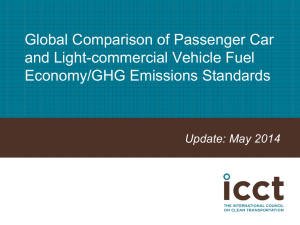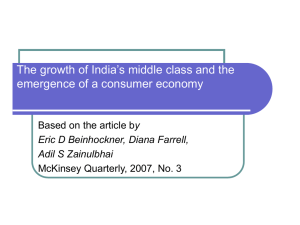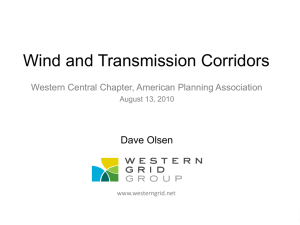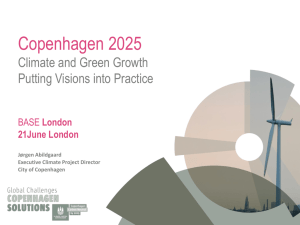Passenger Cars - The International Council on Clean Transportation
advertisement
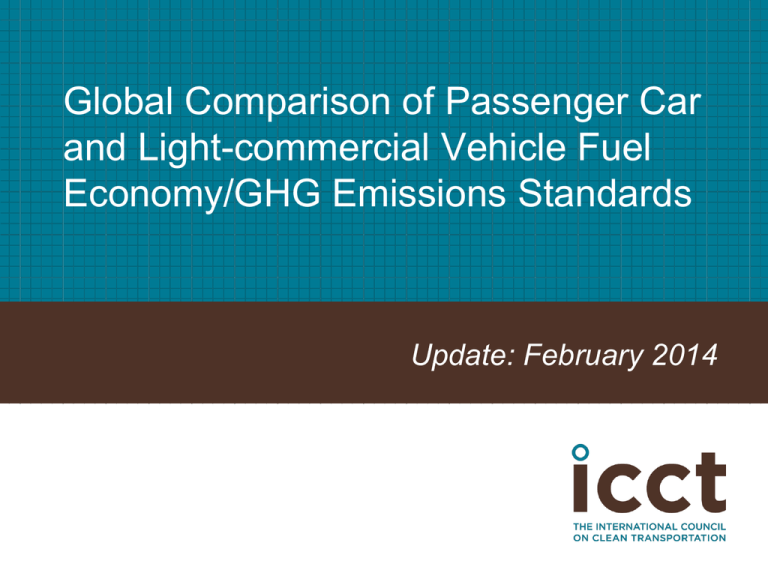
Global Comparison of Passenger Car and Light-commercial Vehicle Fuel Economy/GHG Emissions Standards Update: February 2014 Overview of Regulation Specifications for passenger cars i Assumes manufacturers fully use A/C credit Proposed CAFE standard by NHTSA. It is equivalent to 163g/mi plus CO2 credits for using low-GWP A/C refrigerants. iii In April 2010, Canada announced a target for light-duty vehicle fleet of 246 g/mi for MY2016. The separated targets for car and light truck fleet are estimated by ICCT based on the overall target. iv Canada follows the US standards in the proposal, but the final target value would be based on the projected fleet footprints. FP: footprint ii Overview of Regulation Specifications for Light-commercial Vehicle i Assumes manufacturers fully use A/C credit Proposed CAFE standard by NHTSA. It is equivalent to 163g/mi plus CO2 credits for using low-GWP A/C refrigerants. iii In April 2010, Canada announced a target for light-duty vehicle fleet of 246 g/mi for MY2016. The separated targets for car and light truck fleet are estimated by ICCT based on the overall target. iv Canada follows the US standards in the proposal, but the final target value would be based on the projected fleet footprints. 3 FP: footprint ii Passenger Cars Grams of CO2 per kilometer normalized to NEDC test cycle 240 Solid lines: historical performance Dashed lines: enacted targets Dotted lines: proposed targets or targets under study 220 US Canada Mexico 200 EU 180 Japan 160 China Mexico 2016: 153 S. Korea 2015: 153 Brazil 2017 [3] : 146 S. Korea 140 India 120 China 2020 [1] : 117 100 India 2021: 113 Japan 2020: 105 EU 2021: 95 Brazil US 2025 [2] : 93 Canada 2025:93 80 60 40 20 0 2000 2005 2010 2015 2020 2025 [1] China's target reflects gasoline vehicles only. The target may be higher after new energy vehicles are considered. [2] US standards GHG standards set by EPA, which is slightly different from fuel economy stadards due to low-GWP refrigerant credits. [3] Gasoline in Brazil contains 22% of ethanol (E22), all data in the chart have been converted to gasoline (E00) equivalent [4] Supporting data can be found at: http://www.theicct.org/info-tools/global-passenger-vehicle-standards. 4 Passenger Cars Miles per gasoline gallon normalized to CAFE test cycle 65 60 km/l Solid lines: historical performance Dashed lines: enacted targets Dotted lines: proposed targets or targets under study 27 EU 2021: 60.6 25 Japan 2020: 55.1 55 India 2021: 52 US 2025[2]: 56.2 Canada 2025: 56.2 23 China 2020[1]: 50.1 50 21 US Canada 45 Brazil 2017 [3]: 40.9 19 Mexico S. Korea 2015: 39.3 40 Mexico 2016 : 35.1 17 EU Japan 35 15 30 13 China S. Korea India 25 11 20 2000 9 2005 2010 2015 2020 Brazil 2025 [1] China's target reflects gasoline vehicles only. The target may be higher after new energy vehicles are considered. [2] The U.S. standards are fuel economy standards set by NHTSA, which is slightly different from GHG stadards due to A/C credits. [3] Gasoline in Brazil contains 22% of ethanol (E22), all data in the chart have been converted to gasoline (E00) equivalent [4] Supporting data can be found at: http://www.theicct.org/info-tools/global-passenger-vehicle-standards. 5 Light-commercial vehicle/light-truck Grams of CO2 per kilometer normalized to NEDC test cycle 320 Solid lines: historical performance Dashed lines: enacted targets Dotted lines: proposed targets or targets under study 280 US Canada Mexico EU 240 Japan China Mexico 2016: 208 200 160 Japn 2015: 138 US 2025 [2] :136 EU 2020: 147 120 Canada 2025:136 80 40 0 2000 2005 2010 2015 2020 2025 [1] China's target reflects gasoline vehicles only. The target may be higher after new energy vehicles are considered. [2] US standards GHG standards set by EPA, which is slightly different from fuel economy stadards due to A/C credits. [3] Supporting data can be found at: http://www.theicct.org/info-tools/global-passenger-vehicle-standards. 6 Light-commercial vehicle/light-truck Miles per gasoline gallon normalized to CAFE test cycle 45 km/l Solid lines: historical performance Dashed lines: enacted targets Dotted lines: proposed targets or targets under study 18 Japan 2015: 43.2 EU 2020: 40.7 40 US 2025[2]: 40.3 Canada 2025: 40.3 16 35 14 30 Mexico 2016 : 29.7 12 US 25 10 Canada Mexico EU 20 8 Japan China 15 2000 6 2005 2010 2015 2020 2025 [1] China's target reflects gasoline vehicles only. The target may be higher after new energy vehicles are considered. [2] The U.S. standards are fuel economy standards set by NHTSA, which is slightly different from GHG stadards due to A/C credits [3] Supporting data can be found at: http://www.theicct.org/info-tools/global-passenger-vehicle-standards. 7 Passenger Cars 10 9 Liters per 100 Kilometers (Gasoline Equivalent) normalized to NEDC Test Cycle US Solid lines: historical performance Dashed lines: enacted targets Dotted lines: proposed targets or targets under study Canada Mexico 8 EU Japan 7 China Mexico 2016: 6.5 S. Korea 2015: 6.3 6 Brazil 2017 [3] : 6.3 S. Korea India China 2020[1] : 5.0 5 Brazil India: 4.8 Japan 2020: 4.5 EU 2021: 4.1 4 US 2025[2] : 4.4 Canada 2025: 4.4 3 2 1 0 2000 2005 2010 2015 2020 2025 [1] China's target reflects gasoline vehicles only. The target may be higher after new energy vehicles are considered. [2] The U.S. standards are fuel economy standards set by NHTSA, which is slightly different from GHG stadards due to A/C credits. [3] Gasoline in Brazil contains 22% of ethanol (E22), all data in the chart have been converted to gasoline (E00) equivalent [4] Supporting data can be found at: http://www.theicct.org/info-tools/global-passenger-vehicle-standards. 8 Passenger Cars 3.0 US Canada Mexico 2.5 MJ normalized to CAFE Test Cycle EU Japan 2.0 S. Korea 2015: 1.9 China Mexico 2016 : 1.9 Brazil 2017: 1.8 S. Korea China 2020[1]: 1.5 1.5 India 2021: 1.5 Japan 2020: 1.4 EU 2021: 1.23 India Brazil US 2025[2]: 1.3 Canada 2025: 1.3 1.0 0.5 Solid lines: historical performance Dashed lines: enacted targets Dotted lines: proposed targets or targets under study 0.0 2000 2005 2010 2015 2020 2025 [1] China's target reflects gasoline vehicles only. The target may be higher after new energy vehicles are considered. [2] The U.S. standards are fuel economy standards set by NHTSA, which is slightly different from GHG stadards due to A/C credits. [3] Supporting data can be found at: http://www.theicct.org/info-tools/global-passenger-vehicle-standards. 9 Overall and annual CO2 reduction rates required for passenger cars 10 Overall and annual CO2 reduction rates required for light-commercial vehicles 11 Overall and annual fuel economy improvement rates required for passenger vehicles 12 Overall and annual fuel economy improvement rates required for light-commercial vehicles 13 For more information: http://theicct.org/info-tools/global-passenger-vehicle-standards The International Council on Clean Transportation (ICCT) Washington DC • San Francisco • Berlin http://www.theicct.org/ communications@theicct.org +1 202 534 1600 www.twitter.com/TheICCT 14
